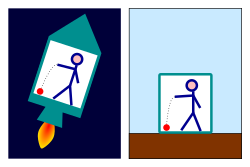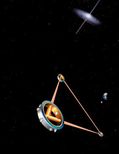General relativity
General relativity is a theory of space and time. The theory was published by Albert Einstein in 1915.[1]
The main idea of general relativity is that space and time are two different parts of spacetime. In general relativity, gravity does not work the same way that Sir Isaac Newton said gravity worked. According to Einstein, gravity changes not only space, but also time (gravitational time dilation).
Idea
An important idea in general relativity is the "principle of equivalence". An example is that two people, one in an elevator on the surface of the Earth, and the other in an elevator in outer space but accelerating upwards at the speed of Earth's gravity will each observe the same behavior of an object they drop from their hands. The object will accelerate to the floor at the speed of Earth's gravity (9.8 m/s2) in either case.
This makes it impossible for either to tell whether or not they are at rest in a gravitational field or accelerating with no gravity. Other versions of this type of "thought experiment" were used to show that light would curve in an accelerating frame of reference.[2]
The force pulling the Earth towards the Sun is about the same as a second force. This second force is called the centrifugal force. The centrifugal force exists because the Earth moves sideways. This sideways motion makes the distance between the Earth and Sun increase. Since the Earth is being pulled towards the sun and moving away at the same time, it stays at about the same distance. This is also how the Moon orbits the earth. In this second case, Earth is the ball and the Moon is the object.
The Sun and other objects with mass curve four dimensional spacetime fabric.[3]
Predictions
General relativity has predicted many things which were later seen. These include:
- As light gets closer to the Sun, it bends towards the sun around twice as much as classical physics predicts (the system used before general relativity). This was seen in an experiment by Arthur Eddington in 1919.[4] When scientists saw his experiment, they started to take general relativity seriously.
- The perihelion of the planet Mercury rotates along its orbit more than is expected under Newtonian physics. General relativity accounts for the difference between what is seen and what is expected without it.
- Redshift from gravity. When light moves away from an object with gravity (going up), it is stretched into longer wavelengths. This was confirmed by the Pound-Rebka experiment. The reverse also happens: light going towards an object with gravity (going down) is shrunk into shorter wavelengths (blueshift).
- The Shapiro delay. Light appears to slow down when it passes close to a massive object. This was first seen in the 1960s by space probes headed towards the planet Venus.
- Gravitational waves. They were first observed on 14 September 2015.[5]
General Relativity Media
According to general relativity, objects in a gravitational field behave similarly to objects within an accelerating enclosure. For example, an observer will see a ball fall the same way in a rocket (left) as it does on Earth (right), provided that the acceleration of the rocket is equal to 9.8 m/s2 (the acceleration due to gravity on the surface of the Earth).
Einstein cross: four images of the same astronomical object, produced by a gravitational lens
Artist's impression of the space-borne gravitational wave detector LISA
Related pages
References
- ↑ O'Connor J.J. and E.F. Robertson (1996), "General relativity". Mathematical Physics index, School of Mathematics and Statistics, University of St. Andrews, Scotland, May, 1996. Retrieved 2015-02-04.
- ↑ Di Casola, Eolo; Liberati, Stefano; Sonego, Sebastiano (2015), "Nonequivalence of equivalence principles", American Journal of Physics, 83 (39): 39–46, arXiv:1310.7426, Bibcode:2015AmJPh..83...39D, doi:10.1119/1.4895342, S2CID 119110646
- ↑ "General Relativity". www.pitt.edu. Retrieved 2021-05-30.
- ↑ Dyson, F. W.; Eddington, A. S.; Davidson, C. (1920), "A Determination of the deflection of light by the Sun's gravitational field, from observations made at the total eclipse of May 29, 1919", Philosophical Transactions of the Royal Society A, 220 (571–581): 291–333, Bibcode:1920RSPTA.220..291D, doi:10.1098/rsta.1920.0009
- ↑ Abbott, Benjamin P.; et al. (LIGO Scientific Collaboration and Virgo Collaboration) (2016). "Observation of Gravitational Waves from a Binary Black Hole Merger". Physical Review Letters. 116 (6): 061102-1–061102-16. arXiv:1602.03837. Bibcode:2016PhRvL.116f1102A. doi:10.1103/PhysRevLett.116.061102. PMID 26918975. S2CID 124959784.
Other websites
| Part of a series of articles about |
| General relativity |
|---|
 |
|
Fundamental concepts
|
|
Phenomena
|
|








